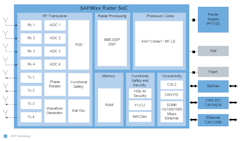3D Radar Taps Advanced Signal Processing for ADAS
This video is part of the TechXchange: Automotive Radar.
What you’ll learn:
- Why 3D radar is important to ADAS and software-defined vehicles.
- How NXP’s SAF86xx SAF86xx radar SoC simplifies antenna deployment.
Advanced driver-assistance systems (ADAS) and software-defined vehicles (SDVs) require a significant amount situational awareness to operate safely. Radar is one of the sensors that provide reliable environment details, but these applications really need 3D radar.
NXP’s SAF86xx radar system-on-chip (SoC) single-chip RFCMOS radar solution leverages advanced signal processing to minimize the number of antennas needed to provide a 3D radar image (see figure). It accomplishes this feat using distributed aperture radar (DAR). Increasing the aperture improves recognition of objects of different sizes moving at different rates.
I talked with Matthias Feulner, Senior Director of ADAS at NXP, about the company’s latest 3D radar technology (watch the video above). The SAF86xx can handle short-, medium- and long-range automotive radar applications.
The SoC has a set of four transmitters and receivers along with the ADC, phase rotator, and low-phase-noise VCO. The analog analysis is handled by the BBE32EP DSP. An Arm Cortex-M7 provides overall system management. It’s linked to a host processing via a gigabit Ethernet port.
The family supports ISO 26262 and ASIL Level B functional-safety standards as well as the ISO/SAE 21434 security standard. The MACSec engine and HSE-M security hardware support is designed to mitigate cybersecurity risks.
Links
About the Author
William G. Wong
Senior Content Director - Electronic Design and Microwaves & RF
I am Editor of Electronic Design focusing on embedded, software, and systems. As Senior Content Director, I also manage Microwaves & RF and I work with a great team of editors to provide engineers, programmers, developers and technical managers with interesting and useful articles and videos on a regular basis. Check out our free newsletters to see the latest content.
You can send press releases for new products for possible coverage on the website. I am also interested in receiving contributed articles for publishing on our website. Use our template and send to me along with a signed release form.
Check out my blog, AltEmbedded on Electronic Design, as well as his latest articles on this site that are listed below.
You can visit my social media via these links:
- AltEmbedded on Electronic Design
- Bill Wong on Facebook
- @AltEmbedded on Twitter
- Bill Wong on LinkedIn
I earned a Bachelor of Electrical Engineering at the Georgia Institute of Technology and a Masters in Computer Science from Rutgers University. I still do a bit of programming using everything from C and C++ to Rust and Ada/SPARK. I do a bit of PHP programming for Drupal websites. I have posted a few Drupal modules.
I still get a hand on software and electronic hardware. Some of this can be found on our Kit Close-Up video series. You can also see me on many of our TechXchange Talk videos. I am interested in a range of projects from robotics to artificial intelligence.


